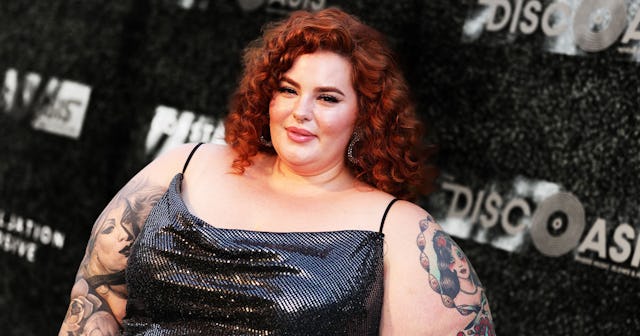Tess Holliday Shows ‘Atypical’ Anorexia Is Still Anorexia

Have you ever heard of atypical anorexia nervosa? When you think of anorexia or hear the word anorexic, one thing comes to mind: thinness. Actually, painful thinness. Thinness to a degree that it begins to deteriorate a person’s physical health. Tragic, devastating Karen Carpenter-level thinness. Most people’s idea of anorexia is inexorably linked to the concept of utter skinniness.
Here’s the thing though: Anorexia is not only for the very, very thin. As a matter of fact, a person can only be diagnosed with anorexia nervosa if they exhibit an intense fear of gaining weight, coupled with an incorrect perception of their own body size. Most of the time, people with classic anorexia nervosa are also losing weight very quickly and are in danger of becoming dangerously underweight, or even dying.
That’s where atypical anorexia comes in. People with an atypical anorexia diagnosis might be an average weight or even have a high body weight.
A few months ago, plus-size model Tess Holliday opened up about her long-time struggle with disordered eating, revealing that she is in recovery from atypical anorexia.
She addressed the many comments she was getting on her changing body, saying, “Yes, I’ve lost weight — I’m healing from an eating disorder & feeding my body regularly for the first time in my entire life. When you equate weight loss with “health” & place value & worth on someone’s size, you are basically saying that we are more valuable now because we are smaller & perpetuating diet culture… & that’s corny as hell. NOT here for it.”
https://www.instagram.com/p/COVvFzTHbSx/
Of course, because she lives in a large body, the internet at large had tons to say about Tess’s atypical anorexia revelation.
The hate was so overwhelming that Tess had to address it, sharing an interview with Good Morning America to her Instagram page, and including the caption, “The last few days have been some of my toughest to date since becoming a public figure. The hate has been overwhelming, but the messages from those of you that felt seen, validated, & loved far outweigh the critics. I’m responding to as many of y’all as I can, but I will be taking a little social break after this to focus on my own mental health. Just remember that having an ED isn’t shameful & you deserve respect & love regardless of where you’re at in your journey with your body.”
https://www.instagram.com/p/COimx7-HYbD
Imagine seeing someone share their painful reality and reacting by accusing them of lying?
People can really suck, especially online. But anyone who doubted Tess Holliday’s atypical anorexia diagnosis based on her size is truly ignorant.
Sure, she looks different than the mental picture you might have of anorexia, but that’s what makes it atypical. The pain, the constant struggle to eat properly, the paralyzing fear of weight gain, and the distorted perception of one’s body … all of those things are the same for everyone struggling with anorexia, whether they are diagnosed with classic or atypical anorexia nervosa.
Eating disorders don’t have a “look,” and discounting fat people’s experiences with disordered eating is not only ignorant and frustrating — it’s harmful and dangerous.
Let’s use my body as an example. I’ve been fat my whole life. I am currently fat enough that if I were to stop eating almost completely, as people with anorexia do, it would take a very long time and an extreme number of pounds for anyone to become concerned about my body weight.
I could be suffering immensely, and nobody would notice. As a matter of fact, like Tess, I would almost certainly find myself on the receiving end of lavish praise for the changes in my appearance, regardless of what my eating patterns were doing to my actual, quantifiable health. There’s nothing the world likes better than a shrinking woman, even if that woman is quite literally dying to be thin.
We have to throw away our pre-conceived notions of what an eating disorder looks like.
According to the National Eating Disorders Association, “eating disorders can affect all kinds of bodies and you cannot tell by looking at someone if they have an eating disorder.” People with atypical anorexia might not look the way you imagine they should look to deserve the diagnosis, but their mental illness is still debilitating and dangerous.
Contrary to what we might have learned from Lifetime movies and after-school specials, it’s not just young, thin white girls who struggle with things like anorexia. On the NEDA website, you’ll find eating disorder resources for athletes, men and boys, people of color, the Jewish community, size-diverse populations, LGBTQIA+ folks, people at mid-life and beyond, and disabled people. There is no population of humans that is not at risk of developing a dangerous and disordered relationship with food and eating.
It’s absolutely non-negotiable that we acknowledge that we can’t diagnose a person as healthy or unhealthy just by looking at them.
Anorexia nervosa has the highest death rate of any mental health disorder, and low body weight alone is not the only contributing factor. The effects of starvation on a body cannot be ignored. Even before a person’s weight dips into a dangerous or life-threatening category, anorexia is wreaking havoc on their body, especially as it pertains to muscle mass and heart health. Fat bodies cannot actually live indefinitely without adequate nutrition, contrary to what some people might think. Every single person needs food to fuel their body, and when anyone at all begins to fall into a pattern of starvation, they will find themselves grave danger.
Atypical anorexia IS anorexia, and a person in any size body deserves support when they choose to be brave enough to share their truth with the world.
This article was originally published on